 |
 |
 |
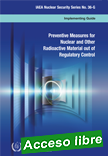 |
Preventive Measures for Nuclear and Other Radioactive Material out of Regulatory Control
IAEA Nuclear Security Series No. 36-G
This publication elaborates upon the recommendations given in IAEA Nuclear Security Series No. 15, Nuclear Security Recommendations on Nuclear and Other Radioactive Material out of Regulatory Control, in relation to preventative measures. It serves as a guidance document for Member States interested in strengthening their nuclear security regime as it relates to nuclear and other radioactive material out of regulatory control and in improving their capabilities.
|
The publication covers the following indicative elements: general considerations for preventive measures; deterrence measures; including deterrence by punishment and deterrence by denial, information security; promotion of nuclear security culture; measures for addressing the insider threat, including measures to promote the trustworthiness of personnel. The last section of the publication provides guidance for international cooperation and assistance to strengthen preventive measures.
|
 |
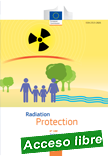 |
Technical Recommendations for Monitoring Individuals for Occupational Intakes of Radionuclides – Radiation Protection
European Commission 2018
This report presents technical recommendations for individual monitoring of workers for occupational intakes of radionuclides. It aims at providing guidance on those aspects of the implementation of the provisions of the Euratom Basic Safety Standards Directive related to individual monitoring of internal exposures, and to encourage harmonisation and the eventual mutual recognition of services.
|
It presents a complete account of the principles of individual monitoring and internal dosimetry, and develops comprehensive guidance and recommendations on best practice. The recommendations cover: (i) roles and duties of dosimetry services; (ii) monitoring programmes; (iii) monitoring methods; (iv) assessment of internal doses from monitoring measurements; (v) accuracy requirements and uncertainty analysis; (vi) quality assurance, and criteria for approval and accreditation; and (vii) radon measurement and dosimetry for workers. Annexes provide supporting information. Topics addressed in the annexes include biokinetic and dosimetric models, monitoring and dosimetry for first responders after a major accident, and the application of internal dosimetry to assessments of risks to health. Finally, there is a set of examples that demonstrate key features of the technical recommendations.
|
 |
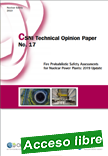 |
CSNI Technical Opinion Paper No. 17
Fire Probabilistic Safety Assessments for Nuclear Power Plants: 2019 Update
English, published: 05/27/19
CSNI Technical Opinion Paper No. 17: Fire Probabilistic Safety Assessments for Nuclear Power Plants: 2019 Update provides an authoritative review of the current status and use of the fire PSA in nuclear power plants. The report demonstrates that while fires at a particular plant site are highly dependent on plant and site specific factors, they are nonetheless an important contributor to overall risk.
|
Insights from fire PSAs are generally found to be aligned with operating experience and to be representative of the expected plant response, making them valuable in addressing risk. This report should be useful for regulators overseeing the use of fire PSAs in nuclear installations, practitioners in understanding the considerations for performing or reviewing fire PSAs, and researchers in identifying areas requiring further study.
|
 |
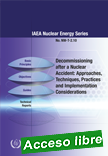 |
Decommissioning after a Nuclear Accident: Approaches, Techniques, Practices and Implementation Considerations
IAEA Nuclear Energy Series NW-T-2.10
This publication describes differences in post-accident situations compared with normal decommissioning (i.e. decommissioning after a planned final shutdown) and identifies significant decision factors as applicable. It focuses on the on-site decommissioning aspects of a technical nature, which need to be addressed after a nuclear accident. Non-technical issues, such as policy and strategy, project planning, organization and management are also covered. |
The collection of experience on approaches, techniques, practices and implementation considerations is based on practical examples and lessons learned from past events, including the Fukushima Daiichi accident. Although the publication addresses decommissioning of nuclear power reactors after an accident, many aspects and considerations are also relevant for non-power nuclear facilities as well as legacy nuclear facilities.
|
 |
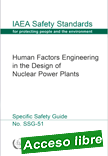 |
Human Factors Engineering in the Design of Nuclear Power Plants
Specific Safety Guide
IAEA Safety Standards Series No. SSG-51
This publication provides recommendations and guidance for meeting Requirement 32 of IAEA Safety Standards Series No. SSR-2/1 (Rev. 1), Safety of Nuclear Power Plants: Design, for optimal operator performance involving systematic consideration of human factors, including the human machine interface (HMI). The Safety Guide provides a structured approach and guidance on application of human factors engineering (HFE) in the design of the HMI, which is the basis for human physical and cognitive processes in nuclear power plants. |
It applies to application of HFE in the design, operation and maintenance of the HMI for new plants, as well as for modifications of the HMI of existing plants.
|
 |
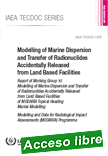 |
Modelling of Marine Dispersion and Transfer of Radionuclides Accidentally Released from Land Based Facilities
Modelling and Data for Radiological Impact Assessments (MODARIA) Programme
IAEA TECDOC No. 1876
This publication describes and summarizes the work of the MODARIA (modelling and data for radiological impact assessments) Programme Working Group 10. MODARIA was set up to continue the IAEA's activities in the field of testing, comparing and developing guidance on the application of models to assess radiation exposures to humans and radiological impacts on the environment.
|
Different aspects of the MODARIA programme were addressed by ten working groups. The current publication presents the work undertaken by Working Group 10 on the modelling of marine dispersion and transfer of radionuclides accidentally released from land-based facilities. Two marine dispersion scenarios were studied. These scenarios simulated dispersion of radionuclides in the Baltic Sea following the Chernobyl accident, and dispersion in the Pacific Ocean following the Fukushima Daiichi nuclear power plant accident. The publication details some general conclusions and presents a comparison of model performance when applied to the above scenarios. The difficulties of developing operative modelling systems for supporting decision making in cases of emergencies in highly dynamic environments are highlighted.
|
 |
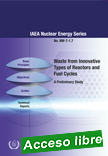 |
Waste from Innovative Types of Reactors and Fuel Cycles
A Preliminary Study
IAEA Nuclear Energy Series NW-T-1.7
For reactors currently operating, the types of wastes expected to be generated under normal operating regime are known and, aside from a few problematic wastes (such as graphite, tritium and radiocarbon) most of these wastes have clearly defined cradle-to-grave (end-to-end) pathways. However, for advanced and innovative reactors and their fuel cycles, some waste types may either have new or different properties or might be problematic for processing with the currently available technologies.
|
One of the primary challenges for advanced and innovative reactors and their nuclear fuel cycles is that solutions must be identified for all eventually problematic wastes prior to initiating construction of these facilities. This publication sets the stage for considering the waste generation of advanced fuel fabrication, reactor operation and decommissioning, reprocessing of spent fuel and waste pathways early in the development of new reactors and their associated fuel cycles. It describes waste flows in broad chemical and physical terms and identifies possible processing, recycling and disposition pathways. The publication is intended to support the nuclear industry in taking an early and integrated approach to waste management.
|
 |
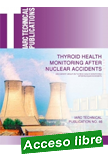 |
Thyroid Health Monitoring after Nuclear Accidents
IARC Technical Publication No. 46
This Technical Publication contains the forward-looking recommendations of a multidisciplinary, international Expert Group on long-term strategies for thyroid health monitoring after a nuclear power plant accident. As a basis for the recommendations, this publication also summarizes the available scientific evidence on thyroid cancer and experiences from past nuclear accidents. The recommendations are intended to specifically address whether thyroid health monitoring should be implemented in a resident population in the vicinity of a nuclear accident and,
|
if so, how such thyroid health monitoring should be prepared for and implemented in the context of general emergency preparedness for and response to nuclear accidents.
This publication was developed with the intention to serve as a reference primarily for the government officials, policy-makers, and health professionals who would be involved in the decision-making, planning, or implementation of thyroid health monitoring in case of a nuclear accident. Because such decision-making may also involve considerations other than the scientific evidence, these recommendations should be used as a reference; the final decision should be made by the government, the relevant authorities, and the society affected by the nuclear accident.
|
 |
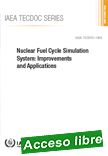 |
Nuclear Fuel Cycle Simulation System: Improvements and Applications
IAEA TECDOC No. 1864
The Nuclear Fuel Cycle Simulation System (NFCSS) is a scenario-based computer simulation tool that can model various nuclear fuel cycle options in various types of nuclear reactors. It is very efficient and accurate in answering questions such as: the nuclear mineral resources and technical infrastructure needed for the front end of the nuclear fuel cycle; the amounts of used fuel, actinide nuclides and high level waste generated for a given reactor fleet size; and the impact of introducing recycling of used fuel on mineral resource savings and waste minimization.
|
Since the first publication on the NFCSS as IAEA-TECDOC-1535 in 2007, there have been significant improvements in the implementation of the NFCSS, including a new extension to thorium fuel cycles, methods to calculate decay heat and radiotoxicity, and demonstration applications to innovative reactors.
|
 |
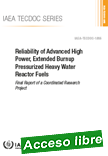 |
Reliability of Advanced High Power, Extended Burnup Pressurized Heavy Water Reactor Fuels
Final Report of a Coordinated Research Project
This publication presents a comprehensive summary of the technical work carried out under an IAEA coordinated research project (CRP) and provides an overview of Member States' approaches to mitigate challenges that are encountered in achieving reliability, sustainability and safety with advanced pressurized heavy water reactor (PHWR) fuels. These challenges, which were discussed and analyzed by the CRP participants,
|
include fuel performance degradation, insufficient availability of operating experience at high burnup and margin erosion by ageing.
|
 |
| |
|
|

|
|
|
| |
|
|
| |
| |
|
|
| |
| |
|
|
| |
| |
|
|
|
| |
| |
